PF3D7_0114100 Pfmc-2TM Maurer's cleft two transmembrane protein (MC-2TM)
Disruptability [+]
| Species | Disruptability | Reference | Submitter |
|---|---|---|---|
| P. falciparum 3D7 |
Possible |
USF piggyBac screen (Insert. mut.) | USF PiggyBac Screen |
Mutant phenotypes [+]
None reported yet. Please press the '+' button above to add one.Imaging data (from Malaria Metabolic Pathways)
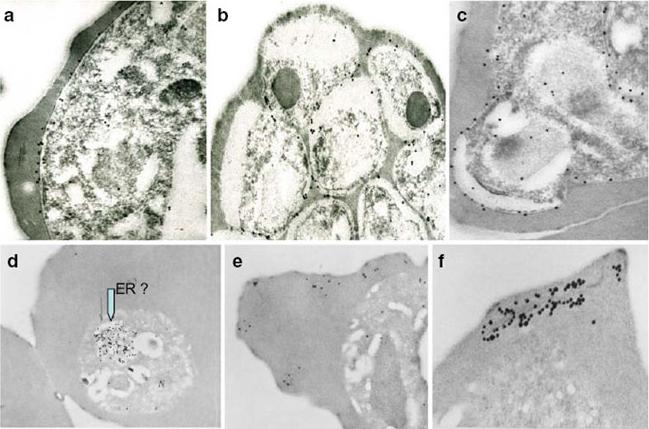
Immunoelectron micrographs of young trophozoite-, late trophozoite-, young schizont-, and late schizont-infected erythrocytes reactive with rabbit antisera against PfMC-2TM peptides, 703, 705, and 713 (identical sequences in all PfMC-2TM-coding genes and Mab SP1A6 against the 130 kDa Maurer’s cleft protein. a–c Peptide-specific antisera are reactive with the PV/PVM and weakly around clefts. d–f Mab SP1A6 is reactive with structures within the parasite in young trophozoites, probably the endoplasmic reticulum (d), late trophozoites in erythrocyte cytoplasm under knobs (e), and in young schizonts around longitudinal clefts in the erythrocyte cytoplasm (f).Tsarukyanova I, Drazba JA, Fujioka H, Yadav SP, Sam-Yellowe TY. Proteins of the Plasmodium falciparum two transmembrane Maurer's cleft protein family, PfMC-2TM, and the 130 kDa Maurer's cleft protein define different domains of the infected erythrocyte intramembranous network. Parasitol Res. 2009 104:875-91. Copyright Springer 2011.
See original on MMP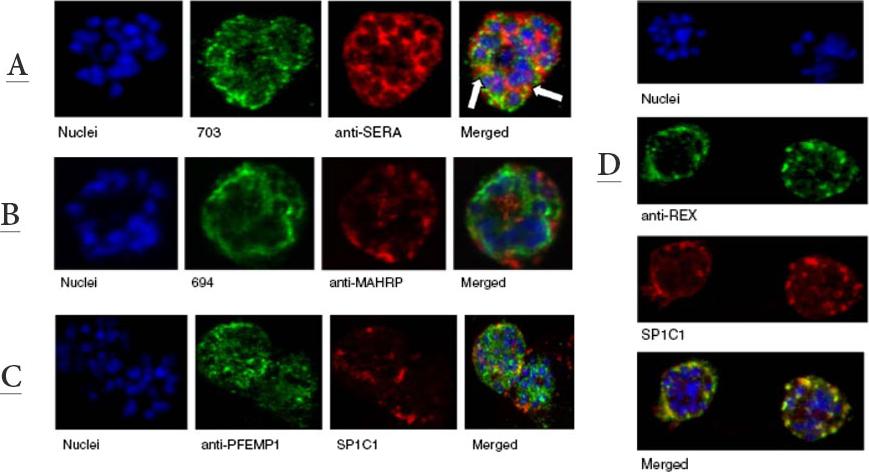
A. Immunofluorescence assay of rabbit antisera against PfMC-2TM peptides colocalized with anti-SERA 1 antibodies. Arrows indicate areas of colocalization between SERA 1 andPfMC-2TMB. Mouse antisera against MAHRP1 MAL13P1.413 was incubated with antisera against PfMC-2TM peptides.C. Immunofluorescence assay of rabbit antisera against PfEMP1 with Mabs SP1C1. PfEMP1 colocalized with PfMC-2TM, D. Immunofluorescence assay of rabbit antisera against REX1 PFI1735c colocalized with Mabs SP1C1. Optical sections were collected at a step size of 0.5 μm from the top to the bottom of the optical plane. Continuous overlap of the antibodies was observed.Tsarukyanova I, Drazba JA, Fujioka H, Yadav SP, Sam-Yellowe TY. Proteins of the Plasmodium falciparum two transmembrane Maurer's cleft protein family, PfMC-2TM, and the 130 kDa Maurer's cleft protein define different domains of the infected erythrocyte intramembranous network. Parasitol Res. 2009 104:875-91. Copyright Springer 2011.
See original on MMP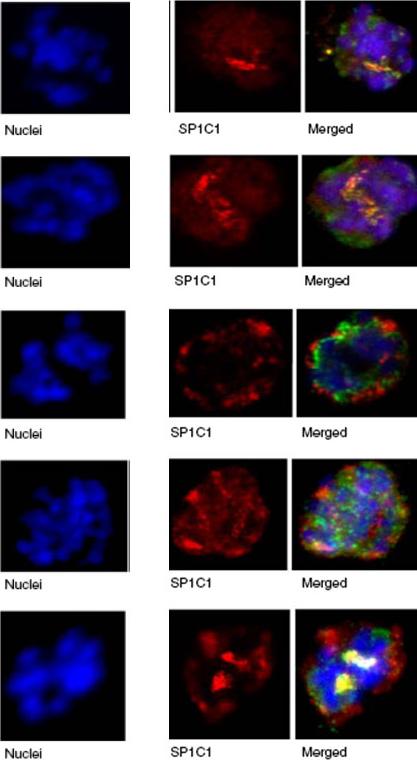
Immunofluorescence assay of rabbit antisera against PfMC-2TM peptides colocalized with Mab SP1C1. Immunofluorescence assays (IFA) in this figure and Figs. 4, 5, 6, 7, 8, and 9 were performed using the same stage of parasites. Trophozoite- and schizont-infected erythrocytes were incubated with mouse and rabbit primary antibodies, followed by secondary antibodies directed to both species, conjugated to different colored fluorochromes; Alexa 488 and Alexa 568 (Molecular Probes) for detection of primary antibodies. Antibody staining was considered colocalized if there was overlap (yellow/orange) in the staining pattern obtained with the two antibodies on or within the same structure or within domains of the intra-membranous network.Tsarukyanova I, Drazba JA, Fujioka H, Yadav SP, Sam-Yellowe TY. Proteins of the Plasmodium falciparum two transmembrane Maurer's cleft protein family, PfMC-2TM, and the 130 kDa Maurer's cleft protein define different domains of the infected erythrocyte intramembranous network. Parasitol Res. 2009 104:875-91. Copyright Springer 2011.
See original on MMP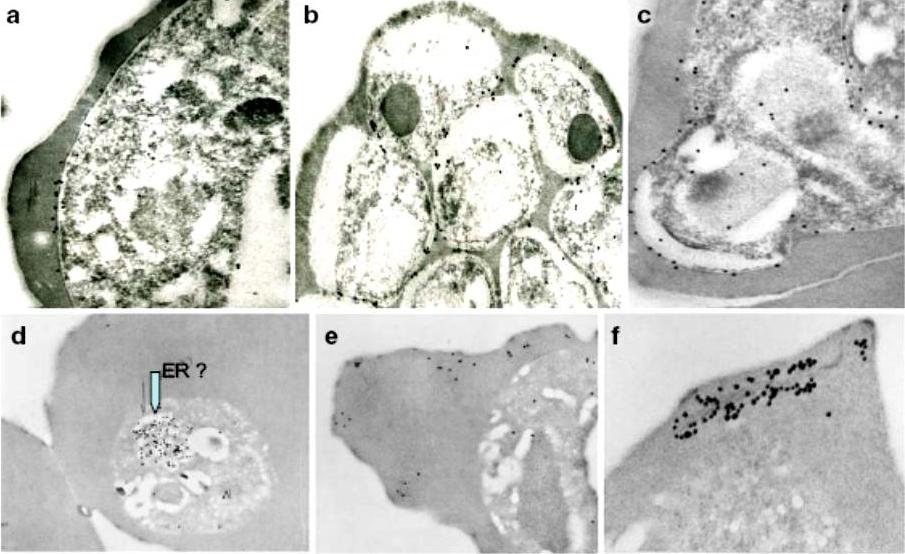
Immunoelectron micrographs of young trophozoite-, late trophozoite-, young schizont-, and late schizont-infected erythrocytes reactive with rabbit antisera against PfMC-2TM peptides, 703, 705, and 713 and Mab SP1A6 against the 130 kDa Maurer’s cleft protein. a–c Peptide-specific antisera are reactive with the PV/PVM and weakly around clefts. d–f Mab SP1A6 is reactive with structures within the parasite in young trophozoites, probably the endoplasmic reticulum (d), late trophozoites in erythrocyte cytoplasm under knobs (e), and in young schizonts around longitudinal clefts in the erythrocyte cytoplasm (f).Tsarukyanova I, Drazba JA, Fujioka H, Yadav SP, Sam-Yellowe TY. Proteins of the Plasmodium falciparum two transmembrane Maurer's cleft protein family, PfMC-2TM, and the 130 kDa Maurer's cleft protein define different domains of the infected erythrocyte intramembranous network. Parasitol Res. 2009 104(4):875-91.
See original on MMP
Upper row: Immunofluorescence assay of rabbit antisera against PfMC-2TM peptides colocalized with anti-SERA antibodies. Arrows indicate areas of colocalization between SERA and PfMC-2TM. Left Panel: Immunofluorescence assay of rabbit antisera against PfEMP1 with Mabs SP1C1 (a), Mab SP1A6 (b), and anti-SERA (c). PfEMP1 colocalized with PfMC-2TM, the 130 kDa Maurer’s cleft protein and SERA. Right panel: Immunofluorescence assay of rabbit antisera against REX PFI1735c colocalized with Mabs SP1C1. Tsarukyanova I, Drazba JA, Fujioka H, Yadav SP, Sam-Yellowe TY. Proteins of the Plasmodium falciparum two transmembrane Maurer's cleft protein family, PfMC-2TM, and the 130 kDa Maurer's cleft protein define different domains of the infected erythrocyte intramembranous network. Parasitol Res. 2009 104(4):875-91.
See original on MMP
Immunogold localization of SFM (Stevor-FLAG-myc) and 2TMFM (Pfmc-2TM-FLAG-myc) recombinant proteins.. Thin sections of late trophozoites and schizonts from pHL-SFM line (a–f) and pHL-2TMFM line (g–l) were probed with an anti-c-myc mAb and revealed by 6 nm gold-labeled anti-mouse IgG. Gold particles were associated with Maurer’s clefts (a, g and h) or the erythrocyte surface (b–f, h, i, k and l). Some particles were associated with knobs (c, f, i and l). Bar, 0.25 mm.Lavazec C, Sanyal S, Templeton TJ. Hypervariability within the Rifin, Stevor and Pfmc-2TM superfamilies in Plasmodium falciparum. Nucleic Acids Res. 2006;34:6696-707.
See original on MMP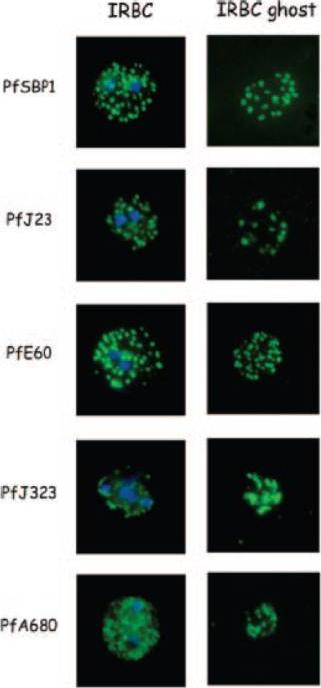
Indirect immunofluorescence of P. falciparum-infected erythrocytes and infected red blood cell (IRBC) ghosts. Air-dried infected red blood cells and infected red blood cell ghosts were incubated with mouse antibodies raised against GST fusion proteins as indicated. The nuclei were stained with DAPI (blue). Negative controls were performed using preimmune sera and anti-GST antibodies (not shown). All proteins are associated with Maurer;s clefts.Vincensini L, Richert S, Blisnick T, Van Dorsselaer A, Leize-Wagner E, Rabilloud T, Braun Breton C. Proteomic analysis identifies novel proteins of the Maurer's clefts, a secretory compartment delivering Plasmodium falciparum proteins to the surface of its host cell. Mol Cell Proteomics. 2005 4:582-93.
See original on MMP
Co-localization of variant surface antigens (VSA) during the intraerythrocytic developmental cycle. A, B: Co-localization of PfEMP1, RIFIN, STEVOR and PfMC-2TM (green) with marker proteins for the erythrocyte membrane (spectrin), the Maurer’s clefts (SBP1) and the merozoite surrounding membrane (MSP1) (red). Subcellular VSA localization was determined in trophozoites (A) as well as in schizonts and free merozites (B) from clinical isolates as well as strain 3D7. Nuclei were stained with DAPI (blue). In the trophozoite stage, RIFIN proteins were exported predominantly to the Maurer’s clefts and the erythrocyte membrane, whereas STEVOR and PfMC-2TM proteins seemed to localize predominantly to the IE membrane. A-type RIFINs, STEVORs and PfMC-2TMs were located in close proximity to the nuclei in dividing parasites in the clinical isolates. In strain 3D7 schizonts, PfMC-2TM family proteins exhibited two distinct localization patterns depending on the antisera used for detection. PfMC-2TM proteins appeared to associate with the parasitophorous vacuole membrane or parasite membrane when using a-PfMC-2TM-SC, while staining with a-PfMC-2TM-CT resulted in a fluorescence pattern similar to RIFIN and STEVOR.Bachmann A, Petter M, Tilly AK, Biller L, Uliczka KA, Duffy MF, Tannich E, Bruchhaus I. Temporal Expression and Localization Patterns of Variant surface Antigens in Clinical Plasmodium falciparum Isolates during Erythrocyte Schizogony. PLoS One. 2012;7(11): e49540.
See original on MMP
Immunolocalization of epitope-tagged proteins. (A) Schematic representation of the SFM (Stevor-FLAG-myc) and 2TMFM (Pfmc-2TM-FLAG-myc) recombinant proteins. For the respective genes, two FLAG epitopes (F) were placed between the 2TM domains and three myc epitopes (M) were inserted at the carboxy terminus. The lengths, in amino acids, of the chimeric proteins are indicated at the bottom. The restriction sites specific for the insertion of tags are indicated. (B) Immunofluorescence assays (IFA) showing the localization of SFM and 2TMFM in the transformed lines, pHL-SFM and pHL-2TMFM. IFA studies were performed on air-dried P. falciparum transformed parasites. Infected erythrocytes were stained with FITC-conjugated anti-c-myc mAb and with anti-FLAG polyclonal antibodies followed by goat anti-rabbit Alexa 594-conjugated IgG. IFA microscopy studies using anti-c-myc and anti-FLAG antibodies showed that the tagged proteins were efficiently expressed within the cytoplasm of infected erythrocytes (B); and both antibodies gave staining patterns that likely correspond to Maurer’s cleft localization.Lavazec C, Sanyal S, Templeton TJ. Hypervariability within the Rifin, Stevor and Pfmc-2TM superfamilies in Plasmodium falciparum. Nucleic Acids Res. 2006;34:6696-707.
See original on MMP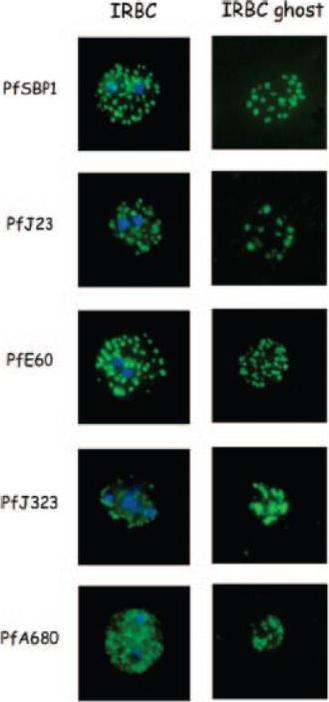
Indirect immunofluorescence of P. falciparum-infected erythrocytes and infected red blood cell (IRBC) ghosts. Air-dried infected red blood cells and infected red blood cell ghosts were incubated with mouse antibodies raised against GST fusion proteins as indicated. The nuclei were stained with DAPI (blue). Negative controls were performed using preimmune sera and anti-GST antibodies (not shown). All proteins are associated with Maurer;s clefts.Vincensini L, Richert S, Blisnick T, Van Dorsselaer A, Leize-Wagner E, Rabilloud T, Braun Breton C. Proteomic analysis identifies novel proteins of the Maurer's clefts, a secretory compartment delivering Plasmodium falciparum proteins to the surface of its host cell. Mol Cell Proteomics. 2005 4:582-93.
See original on MMP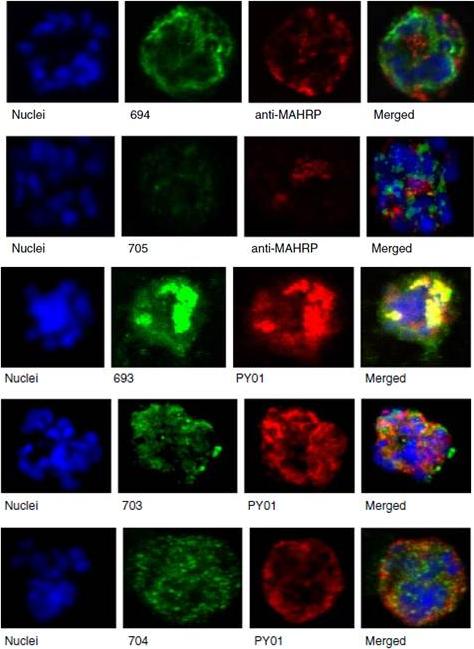
Upper panel: Mouse antisera against MAHRP1 was incubated with antisera against PfMC-2TM peptides and antisera. Lower panel: Immunofluorescence assay of mouse antisera against Rhop-3 (PY01) was incubated with rabbit antibodies against PfMC-2TM on smears of mature schizonts;Tsarukyanova I, Drazba JA, Fujioka H, Yadav SP, Sam-Yellowe TY. Proteins of the Plasmodium falciparum two transmembrane Maurer's cleft protein family, PfMC-2TM, and the 130 kDa Maurer's cleft protein define different domains of the infected erythrocyte intramembranous network. Parasitol Res. 2009 104(4):875-91.
See original on MMPMore information
| PlasmoDB | PF3D7_0114100 |
| GeneDB | PF3D7_0114100 |
| Malaria Metabolic Pathways | Localisation images Pathways mapped to |
| Previous ID(s) | MAL1P4.14, PFA0680c |
| Orthologs | |
| Google Scholar | Search for all mentions of this gene |